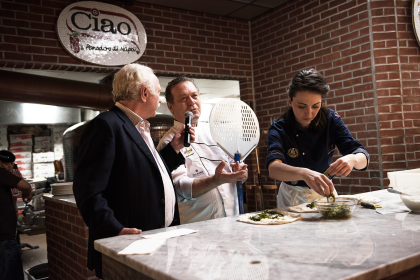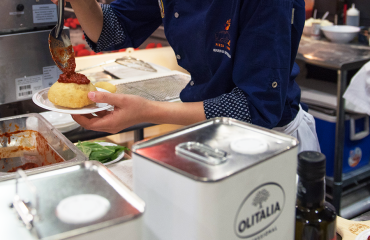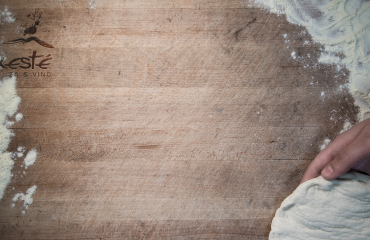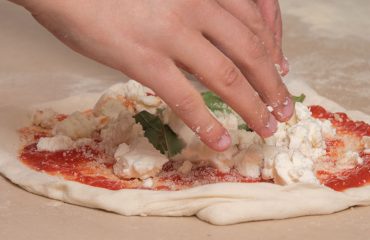
NEW YORK – Roberto Caporuscio, 58-years-old, left Italy twenty years ago. Until then, he had worked on the family farm in Pontinia, that fertile part of Lazio with a view toward the Campania region. His farm produced seeds that were exported and it was also a dairy farm. The affair of fines connected to milk quotas that damaged many breeders during that period forced him to close the farm at a certain point. He had to start from scratch and reinvent a life for himself. “I got back into the game – he recounts – at 38 years of age I decided to learn how to be a pizza chef because I had a cousin who had opened an Italian pizzeria in the Turks and Caicos islands in the Caribbean who offered me a job. However, I decided that I wanted to learn that trade in the best place on earth, which was close to my home: Naples.”
The story
Roberto obtained his certificate from the Associazione dei Pizzaiuoli napoletani school for pizza chefs. Where true traditional Neapolitan pizza is taught, the pizza sold on the street which is eaten in Naples like in no other place in the world. “I had various teachers, famous pizza chefs, who revealed their secrets and I went from there.” Before moving to the Caribbean, he decided to stop in the United States to learn English. In 1999, he found work in a pizzeria in Pittsburgh, Pennsylvania, classic America, on the eve of the new millennium. “One day an Italian-American who had been won over by my pizza proposed a partnership to open a pizzeria.” Plans changed again.
Pizzeria Regina Margherita opened its doors to the public in 2001, just a few weeks before the attack on the World Trade Center. Roberto wanted to make pizza like in Naples. And it was a revolution for Americans at that time. It was an immediate success and he soon became famous among pizza chefs. So much that, a few years later in 2007, he decided to open a new, larger pizzeria in Ridgewood, New Jersey. And, after another two years, in the America of the self-made men where everything happens at a fast pace, Roberto decided to take the big leap and open another pizzeria in New York, the city that never sleeps, where the competition is fierce and work rhythms are crazy compared to the American suburbs.
The name he chose for the pizzeria was Kesté. In Neapolitan “quest’ è” (“this is it” or “it is what it is”). It was spelled with a K to avoid any incorrect pronunciation by the Americans. The name embodies the entire philosophy of his restaurant: no meatballs, no French Fries or other strange toppings: pizza like in Naples is made here. Full stop. Without compromises. Without TV screens to watch the matches. Without catering to the tastes and fashions of American consumers.
Training
The first Kesté pizzeria was opened on Bleecker Street in the Village on 24 March 2009. Three months later, NyMagazine ranked it at the top of the list for New York pizzerias. Some time later, Time Out did the same. Now that he was here in New York, as he had learned from the Neapolitan pizza masters, Roberto also sought to spread awareness of real Neapolitan pizza among local pizza chefs. From 2007, he began to travel around the United States on behalf of the Associazione dei pizzaiuoli napoletani. Since then, he has trained 270 professional pizza chefs in the States, Canada and Latin America on true traditional pizza. “I explained how to use the flour, which raw materials to choose, how to make the dough rise and the baking process.”
Shared knowledge for a simple food which, however, few know how to make well. “In America, there was no Neapolitan pizza. Pizza was made with low quality flours, in gas ovens, crispy and with mozzarella that wasn’t mozzarella. In short, the quality was very low. At that time, there were only about twenty of us making real Neapolitan pizza anywhere in the States. Now there has been a true and proper explosion.” In the meantime, he now had three pizzerias in New York. In addition to the first Kesté on Bleecker Street, in 2012 he opened a second pizzeria in New York: “Don Antonio”, at 309 West 50th street “in honour of one of my pizza chef teachers from Naples, Antonio Staruta who, at 75-plus years, is still making pizza in Italy. Most recently, he opened his third pizzeria in 2017, the second under the Kesté brand, on Fulton Street, just a few yards from the metro stop in the financial district, not far from Ground Zero: able to accommodate 155 and a restaurant that was entirely created with the furnishing and materials of a true nineteenth-century Neapolitan pizzeria. He shows me a book. “I started from this text: “Habits and customs of Neapolitans” by Francesco Boucard in 1857, in the era of the Kingdom of Naples. I dug it out of the ancient bookshelves of Naples and I paid one thousand Euro for an original copy. It talks about how the pizza was and how the pizzerias were then.” The job of furnishing the Fulton Street Kesté pizzeria was entrusted to a young Neapolitan architect who used hand painted Salerno majolica from Baronissi and Lecce white stone from Manturia to reconstruct the atmosphere.
“I just want – Caporuscio explains – to retrace tradition and I don’t want pizza to become like spaghetti and meatballs”, spaghetti revisited by Americans who added meatballs to it. “Real Neapolitan pizza is our trademark.” Eighty people work in his three New York restaurants, twenty years after the start of his second life, many of them Italian young people, but not all.
The people’s pizza
The Neapolitan pizzeria was there. As was the Neapolitan pizza. Only one thing was missing: the price. For a sit-down pizza in New York, often of poor quality, you will spend no less than ten Dollars on average. “I thought that this detail was missing to make it so that even in New York you could find true Neapolitan pizza: the price. In Naples, a Margherita (plain) pizza costs four Euro and you can buy it anywhere on the street. Pizza brings all social classes together: attorneys eat it alongside the unlicensed car park attendants. It is a normal thing. A social fact that places people on common ground.”
And so, three months ago, Caporuscio launched the idea of the people’s pizza. “We introduced three pizzas on our menu, the most common, permanently at 5 Dollars: the Margherita, the Marinara and the Mastronicola, a 1600 era pizza, white with Pecorino Romano cheese and sugna (lard)”. White, because in that period, there were no tomatoes, which arrived in Naples in the eighteenth century with the Bourbons who had brought them from Peru. “The Spaniards didn’t use them in cooking because they thought they were an ornamental plant. Tomato as a sauce originated in Naples, in the shadow of Vesuvius.” As he talks, Roberto has three 5-Dollar “people’s” pizzas prepared, which are the equivalent of four Neapolitan Euro. Indeed, the flavour, fragrance and odour are the same as the pizzas eaten in the neighbourhoods of Naples. If you have ever tried a pizza in the Neapolitan city, it is one of those sensory experiences that are filed away in the deepest memories of good things. Something that remains imprinted inside of you. The people’s pizza reminded me of those sensations.
Made in Napoli
In order to philologically reconstruct Neapolitan pizza in New York, Roberto brings flours from Naples, from the Caputo mill which is the leading pizza flour supplier. “There is no comparison with the American flours that are full of chemical additives, impossible to work and rise this way. The wheat in the United States with fertiliser grows in two months and it is difficult to use – too elastic. In Italy, it takes seven months for the wheat to grow. The flours have no additives and are much softer.” The pizza dough rises for 48 hours, 24 hours at room temperature and then rolled into balls. “In the end, a highly digestible and much lighter product comes out because the pizza does not rise in your stomach and it doesn’t make you feel bloated like those poor quality products that rise too quickly do.
The same takes place for the tomatoes used in the pizza that comes from the Campania region. Pino Daniele comes on over the restaurant’s background music. “The tomatoes are from Agro Nocerino from the Ciao brand of the Mercantile Company.” Even the wood burning ovens come from Naples. “It takes a pizza nine seconds to bake in these ovens”.
The secret: homemade mozzarella
There are no secrets in true Neapolitan pizza. Only a respect for the raw materials and tradition. “The recipe – the master pizza chef explains – is always the same: 1 gram of brewer’s yeast for 1,650 grams of flour and one litre of water. 50 grams of salt are added to this. But, if you make it at home, where you don’t have these ovens, add 15 grams of extra virgin oil and 10 grams of sugar.” The final fundamental ingredient is the mozzarella. In order to successfully make pizza as good as in Naples, Roberto opened a small dairy in the pizzeria: every night, master cheese-makers produce ultra-fresh fiordilatte for Kesté. “My first life as a breeder and farmer helped me to understand the value of the raw material. Now I try to promote the work of those who are also at the beginning of the supply chain to produce a truly high quality pizza with genuine ingredients.” Without any shortcuts.
The pizza Academy
Beside the pizzeria, he opened an Academy where he holds training courses for pizza chefs – in the meantime, Roberto Caporuscio has become president of the Associazione Pizzaiouli Americani where the U immediately indicates the true traditional Neapolitan pizza – but there are also team building courses for companies, courses for ladies who want to learn the art of pizza and natural rising or laboratories with school children. His daughter, Giorgia, 27 years of age and a master pizza chef who won the Caputo Trophy in 2014 as best pizza chef for classic pizza in Naples, helps her dad, taking care of all the training course operations.
The people’s pizza is just the latest challenge. A five-Dollar pizza for all. “We decided to put it on the menu permanently at that price to demonstrate what pizza really is. Pizza is something that is for everyone. A social product that brings people together and has a family feeling.” And he talks about an American film in Naples with Julia Roberts who stops to have a pizza on the street from none other than one of his teachers, Michele. “If you go to Michele in Naples, you only have two choices of pizza. That’s it.” Kesté. “The message we want to convey is that pizza makes people feel good and brings them together.” Just recently, on December seventh, the one year anniversary of pizza being added by Unesco to the World Heritage list was celebrated. “The concept of the people’s pizza – Roberto reiterates – is not a business theme, but rather a social theme. Taking the Americans to the point of saying “let’s talk about it over a pizza”, rather than over a drink, as is often the case, remains a challenge to bring them closer to the true Italian tradition of pizza, not only in terms of the quality of the ingredients, but especially in terms of the mentality and spirit of going to the pizzeria.” Ultimately, Roberto Caporuscio’s challenge in the city that never sleeps and is always in a rush is to create and convey the value of the conviviality, time and care dedicated to what is placed on the plate.
Click here to read the article in Italian.
Copyright by Marco Cimminella from Business Insider Italia


